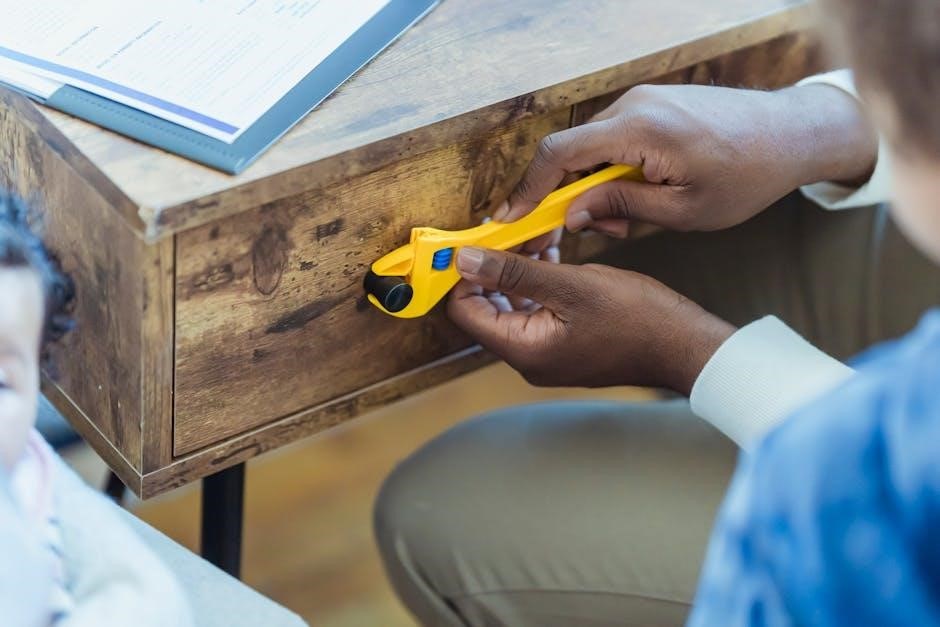A Relationship User Manual is a personalized guide for understanding each other’s needs and preferences. It helps reduce misunderstandings and strengthens emotional bonds, fostering better communication and connection in any relationship.
1.1 What is a Relationship User Manual?
A Relationship User Manual is a personalized document designed to guide understanding of an individual’s needs, preferences, and boundaries in relationships. It serves as a roadmap for effective communication, helping partners navigate interactions with clarity. This manual outlines how someone operates in relationships, including their emotional triggers, communication styles, and expectations. It also covers personal “bugs” or quirks, as well as strengths, fostering mutual understanding. The concept originated in the polyamorous community but has broader applications, including romantic partnerships, friendships, and professional relationships. By documenting these aspects, the manual reduces misunderstandings and enhances emotional connections, allowing individuals to align their behaviors with each other’s needs. It’s a flexible tool that can be tailored to suit different relationship dynamics, ensuring open and intentional interactions. Essentially, it’s a proactive approach to building harmony and intimacy by providing insight into what makes each person tick.
1.2 Purpose and Benefits
The primary purpose of a Relationship User Manual is to enhance understanding and communication within relationships, ensuring both partners feel seen and heard. By documenting individual needs, preferences, and boundaries, it fosters clarity and reduces the likelihood of misunderstandings. This tool promotes emotional intimacy by encouraging open dialogue about expectations and desires. It also serves as a guide for navigating conflicts constructively, helping partners address issues before they escalate. The benefits extend to strengthening emotional bonds, improving mutual respect, and creating a foundation of trust. It empowers individuals to take responsibility for their actions and emotions, fostering a culture of accountability and empathy. Additionally, it provides a framework for personal growth, allowing individuals to reflect on their behavior and communication styles. Ultimately, the manual acts as a proactive approach to building stronger, more intentional relationships, ensuring both partners feel valued and understood.

Importance of a Relationship User Manual
A Relationship User Manual is crucial for fostering clear communication, preventing conflicts, and deepening mutual understanding. It ensures both partners feel valued, promoting a harmonious and intentional relationship dynamic.
2.1 Understanding Each Other’s Needs
Understanding each other’s needs is foundational to a thriving relationship. A Relationship User Manual helps both partners identify and communicate their preferences, boundaries, and emotional triggers, fostering a supportive environment. By clarifying these aspects, couples can navigate interactions with empathy and intention, reducing misunderstandings. This process encourages open dialogue, ensuring both partners feel heard and valued. It also highlights the importance of adaptability, as needs may evolve over time. Regularly updating the manual ensures it remains relevant, addressing new challenges and deepening emotional connections. Ultimately, this mutual understanding creates a stronger, more compassionate relationship dynamic.
2.2 Reducing Misunderstandings and Conflicts
A Relationship User Manual plays a crucial role in minimizing misunderstandings and conflicts by providing clarity on each partner’s expectations and boundaries. By documenting preferences, communication styles, and conflict resolution strategies, couples can address issues before they escalate. This guide helps eliminate assumptions, ensuring both partners are on the same page. It also fosters a proactive approach to resolving disagreements, encouraging constructive conversations rather than reactive arguments. Over time, this reduces friction and creates a more harmonious relationship dynamic. The manual serves as a reference point, helping partners navigate challenging situations with empathy and understanding. Regular updates to the manual ensure it remains relevant, adapting to the evolving needs of the relationship. Ultimately, it becomes a powerful tool for maintaining peace and strengthening the bond between partners.
2.3 Building Stronger Emotional Connections
A Relationship User Manual is a powerful tool for deepening emotional intimacy and fostering stronger connections. By outlining each partner’s emotional needs, love languages, and preferences, the manual creates a roadmap for understanding and supporting one another. It encourages open dialogue about what brings joy, comfort, and fulfillment, helping partners feel seen and valued. This guide also highlights how to navigate emotional triggers and vulnerabilities, promoting empathy and compassion. Regularly referencing the manual ensures consistent effort in meeting each other’s emotional needs, leading to more meaningful interactions. Over time, this shared understanding cultivates a sense of security and closeness, strengthening the emotional bond. The manual becomes a foundation for building trust and connection, allowing relationships to grow more deeply and authentically. By prioritizing emotional connection, couples can create a more fulfilling and resilient partnership.

Creating Your Relationship User Manual
Creating a Relationship User Manual involves identifying each partner’s needs, boundaries, and preferences. It outlines communication styles, emotional triggers, and love languages, serving as a collaborative guide to foster understanding and connection. Regular updates ensure relevance.
3.1 Essential Sections to Include
A Relationship User Manual should include key sections to ensure clarity and depth. Start with a personal overview, detailing your values, boundaries, and non-negotiables. Next, outline communication preferences, such as active listening habits and conflict resolution strategies. Emotional needs, love languages, and intimacy expectations should be clearly defined. Include sections on how you prefer to receive affection, handle feedback, and manage independence within the relationship. Additionally, list triggers and stress responses to help your partner understand how to support you. Financial expectations, shared goals, and long-term visions are also important. Finally, dedicate a section to personal growth and how you envision evolving together. These elements create a comprehensive guide, fostering mutual understanding and alignment. Regular updates ensure the manual remains relevant as your relationship grows and changes over time.
3.2 How to Personalize Your Manual
Personalizing your Relationship User Manual involves tailoring it to reflect your unique needs and preferences. Start by reflecting on past relationships to identify patterns and areas for improvement. Consider your emotional triggers, communication style, and how you prefer to give and receive affection. Include personal anecdotes or examples to illustrate key points, making the manual feel authentic and relatable. Customize sections like “How to Support Me” or “My Love Languages” to ensure clarity. Use bullet points or checklists for easy readability. You can also add visual elements, such as photos or quotes, to make it more engaging. Regularly update the manual to reflect personal growth and changes in your relationship. Remember, the goal is to create a document that feels like “you” and fosters deeper connection with your partner. By personalizing each section, you ensure the manual remains relevant and impactful over time.
3.3 Involving Your Partner in the Process
Involving your partner in creating your Relationship User Manual ensures it reflects both of your voices and needs. Start by having an open conversation about the purpose of the manual and how it can benefit your relationship. Encourage your partner to share their thoughts, boundaries, and preferences openly. Use active listening to understand their perspective and validate their feelings. Collaborate on each section, ensuring mutual input and agreement. This process fosters teamwork and strengthens your connection. Regularly review and update the manual together to adapt to changes in your relationship. By involving your partner, you create a shared understanding and commitment to nurturing your bond. This collaborative effort ensures the manual becomes a meaningful tool for both of you, promoting mutual respect and empathy. Remember, the goal is to build a document that reflects your shared values and goals, fostering a healthier and more fulfilling relationship.

Communication Strategies
Effective communication is the cornerstone of any successful relationship. A Relationship User Manual emphasizes active listening and clear expression of feelings, helping partners convey their needs and understand each other deeply.
4.1 Active Listening
Active listening is a cornerstone of effective communication in relationships. It involves fully engaging with your partner, understanding their perspective, and acknowledging their emotions. This technique helps in building trust and intimacy. By giving your undivided attention, you show respect and value their thoughts. Active listening also involves verbal and non-verbal cues, such as nodding, maintaining eye contact, and summarizing what they say. This ensures clarity and prevents misunderstandings. Regular practice fosters empathy and strengthens your emotional connection. It also helps in addressing issues before they escalate, creating a safe space for open dialogue. Over time, active listening becomes a habit, enhancing communication and deepening mutual understanding. Incorporating this strategy into your Relationship User Manual can significantly improve how both partners interact and respond to each other’s needs. It’s a simple yet powerful tool for nurturing a healthy and fulfilling relationship. Consistency is key to seeing long-term benefits.
4.2 Effective Expression of Feelings and Needs
Effectively expressing your feelings and needs is crucial for fostering a healthy and understanding relationship. It involves using clear and honest communication to convey emotions and expectations. By practicing this, both partners can avoid misunderstandings and feel heard. “I” statements are a powerful tool, as they focus on your own feelings rather than blaming your partner. For example, saying “I feel hurt when…” instead of “You always…” helps to create a safe space for dialogue. Clarity and specificity are key—expressing exactly what you need and how you feel ensures your partner understands your perspective. This approach also encourages empathy and validation, allowing both individuals to connect on a deeper level. Regularly practicing this skill strengthens trust and intimacy, making it easier to navigate challenges together. Incorporating this strategy into your Relationship User Manual ensures both partners are aligned and fulfilled in the relationship. Over time, it becomes second nature, fostering a culture of openness and mutual respect. Consistent effort in this area can lead to significant improvements in communication and relationship satisfaction.

Emotional Intelligence in Relationships
Emotional intelligence is crucial for understanding and managing emotions, fostering empathy, and improving communication. It helps partners recognize each other’s feelings, leading to deeper connections and healthier conflict resolution in relationships.
5.1 Understanding and Managing Your Emotions
Understanding and managing your emotions is a cornerstone of emotional intelligence in relationships. It involves recognizing your emotional triggers, acknowledging how you feel, and learning to respond rather than react. Self-awareness is key, as it allows you to identify patterns and take control of your emotions before they escalate. By practicing mindfulness and reflection, you can better navigate situations that might otherwise lead to conflict. Journaling or talking to a trusted partner can also help you process emotions healthily. Managing emotions effectively fosters a safer and more supportive environment for both partners, encouraging open communication and empathy. This skill is essential for maintaining harmony and building a strong emotional connection in any relationship.
- Recognize emotional triggers and patterns.
- Practice mindfulness to manage reactions.
- Use journaling or open communication to process feelings.
Mastering emotional regulation strengthens relationships and promotes mutual understanding.
5.2 Empathy and Perspective-Taking
Empathy and perspective-taking are vital skills for fostering deep emotional connections in relationships. Empathy allows you to understand and share your partner’s feelings, while perspective-taking helps you see situations from their point of view. These skills enable you to respond compassionately and avoid misunderstandings. By putting yourself in your partner’s shoes, you can better appreciate their needs, desires, and challenges. Practicing active listening and asking open-ended questions can enhance your ability to empathize. For example, acknowledging their feelings with phrases like “I can see why you’d feel that way” shows understanding and validation. This not only strengthens trust but also creates a safe space for open communication. Cultivating empathy and perspective-taking fosters mutual respect and collaboration, helping you navigate conflicts with care and sensitivity.
- Practice active listening to understand your partner’s emotions.
- Ask open-ended questions to gain insight into their perspective.
- Acknowledge their feelings to show empathy and validation.
Empathy and perspective-taking are essential for building a supportive and understanding relationship.
5.3 Self-Regulation in Conflict Situations
Self-regulation is a critical skill for managing emotions during conflicts, ensuring they remain constructive rather than destructive. It involves recognizing your emotional triggers and taking steps to calm yourself before reacting. Techniques like taking a moment to breathe, stepping away temporarily, or practicing mindfulness can help maintain control. Self-regulation also means being aware of how your words and actions may impact your partner, fostering a more respectful dialogue. By remaining calm and composed, you can address issues more rationally and avoid escalations. This skill strengthens trust and promotes healthier conflict resolution, allowing both partners to feel heard and understood.
- Recognize emotional triggers to prevent impulsive reactions.
- Use pause or timeout strategies to regain composure.
- Practice mindfulness to stay present and focused.
Mastering self-regulation enhances your ability to navigate conflicts with empathy and clarity.

Conflict Resolution
Conflict resolution strengthens relationships through understanding and trust. It involves addressing disagreements with empathy and assertiveness, ensuring both partners feel heard. Strategies include active listening, clear expression of feelings, and seeking mutual solutions.
6.1 Approaches to Handling Disagreements
Effective approaches to handling disagreements involve active listening, empathy, and clear communication. Understanding each other’s perspectives fosters mutual respect and reduces conflict escalation. Using “I” statements helps express feelings without blame, promoting constructive dialogue. Remaining calm and avoiding defensiveness allows for rational problem-solving. Compromise and seeking mutually beneficial solutions strengthen trust and understanding. Regularly addressing issues prevents resentment buildup, ensuring healthy relationship growth. Open dialogue and willingness to adapt are key to resolving conflicts positively, fostering a stronger emotional connection and shared goals. These strategies, outlined in a Relationship User Manual, guide partners toward harmonious resolution, enhancing relationship satisfaction and longevity.
6.2 Techniques for Constructive Arguments
Constructive arguments rely on techniques that promote understanding and resolution. Active listening ensures both partners feel heard, while expressing feelings without blame fosters openness. Setting ground rules, like avoiding personal attacks, maintains respect. Taking breaks to cool down prevents escalation, allowing for clearer communication. Focusing on the present issue avoids bringing up past grievances. Using non-defensive language and seeking solutions together strengthens collaboration. Acknowledging each other’s perspectives builds empathy and mutual respect. These techniques, when applied consistently, can transform conflicts into opportunities for growth and deeper connection. Regularly practicing these methods ensures arguments remain productive and respectful, enhancing relationship satisfaction and resilience over time.

Building and Maintaining Intimacy
Building and maintaining intimacy involves nurturing emotional and physical connection. Regular affection, meaningful communication, and trust foster closeness. Consistent effort and vulnerability strengthen the bond, ensuring a fulfilling and enduring relationship.
7.1 Emotional and Physical Intimacy
Emotional and physical intimacy are vital components of a fulfilling relationship. Emotional intimacy involves deep trust, vulnerability, and open communication, where both partners feel safe sharing their thoughts and feelings. Physical intimacy, on the other hand, encompasses affectionate gestures, touch, and closeness, which strengthen the bond between partners. Balancing both forms of intimacy fosters a deeper connection and mutual understanding. Regular date nights, surprise gestures, and shared activities can help maintain emotional closeness. Physical touch, such as holding hands or cuddling, releases oxytocin, the “love hormone,” which reinforces attachment. Maintaining intimacy requires effort and intention, especially as life circumstances change. By prioritizing quality time and affection, couples can nurture a strong emotional and physical connection, ensuring a lasting and satisfying relationship.
7.2 Maintaining Connection and Affection
Maintaining connection and affection in a relationship requires consistent effort and intention. Regular date nights, surprise gestures, and meaningful conversations can help keep the spark alive. Expressing gratitude and appreciation through small acts, like leaving love notes or giving compliments, fosters a positive emotional environment. Shared activities, such as hobbies or rituals, strengthen bonding and create lasting memories. Physical affection, like holding hands or cuddling, releases oxytocin, which deepens emotional closeness. Scheduling regular check-ins ensures both partners feel heard and valued. It’s important to adapt these practices to suit each partner’s preferences and needs. Over time, life’s demands can strain connection, but prioritizing quality time and affection ensures the relationship remains vibrant. By nurturing emotional and physical closeness, couples build a foundation of trust, intimacy, and mutual support.

Navigating Challenges in Relationships
Navigating challenges requires emotional resilience, effective strategies, and open communication. Addressing conflicts, external pressures, and financial decisions collaboratively fosters growth and strengthens the bond, ensuring both partners feel supported and heard.
8.1 Handling External Pressures
External pressures, such as societal expectations, family demands, or work-related stress, can significantly impact a relationship. These pressures often create tension and strain, requiring couples to develop strategies to navigate them effectively. Open communication is key, as it allows partners to express their feelings and concerns about external influences. Setting clear boundaries can help protect the relationship from outside interference, ensuring that both individuals feel respected and prioritized. Additionally, building a support system, whether through mutual friends or professional counseling, can provide relief and guidance. By addressing external pressures collaboratively, couples can strengthen their bond and maintain a healthy, balanced relationship despite external challenges. Regular check-ins and proactive problem-solving can also help mitigate the impact of these pressures, fostering resilience and understanding in the partnership.
8.2 Managing Digital Communication
Digital communication plays a significant role in modern relationships, offering convenience but also potential challenges. Couples must establish clear boundaries and expectations to avoid misunderstandings. Regularly discussing preferences for communication platforms, response times, and content sharing can help prevent conflicts. It’s important to balance digital interactions with quality face-to-face time, ensuring that technology enhances rather than detracts from the relationship. Active listening and clarity in digital messages are crucial to avoid misinterpretation. Additionally, partners should agree on privacy settings and personal boundaries to maintain trust. Mindful use of social media can reduce unnecessary stress and comparisons. By fostering open dialogue about digital habits, couples can create a healthy balance between connectivity and intimacy, ensuring that technology strengthens their bond rather than creating distance. Regular check-ins about digital communication practices can further reinforce mutual understanding and respect in the relationship;
8.3 Financial Considerations and Decisions
Financial considerations are a critical aspect of any relationship, often serving as a source of both harmony and conflict. Open and honest communication about financial habits, goals, and priorities is essential to avoid misunderstandings. Couples should discuss and agree on budgeting, spending habits, and savings strategies to ensure alignment. It’s important to establish roles in financial decision-making, whether one partner manages the finances or responsibilities are shared equally. Creating a shared budget and regularly reviewing it can help both partners stay on the same page. Additionally, decisions about major purchases, investments, or debt should be made collaboratively to ensure mutual comfort and understanding. Transparency about financial obligations, such as loans or credit card debt, is vital to building trust. By addressing financial matters thoughtfully and respectfully, couples can reduce stress and foster a sense of teamwork in managing their shared financial future. This section of the manual should reflect the unique financial dynamics of the relationship.
